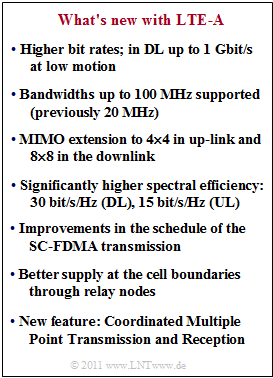Exercise 4.5: LTE vs LTE-Advanced
From LNTwww
Since summer 2011, LTE is on the verge of commercial use, and construction and expansion work is currently underway in more and more major cities. Even if - as with previous standards - it will still take some time before all interested parties can enjoy the benefits of this fourth-generation mobile communications system: $ {\rm LTE}$ is on the advance.
At the same time, the successor ${\rm LTE-Advanced}$ (LTE-A for short) has already reached the final stage of specification.
- In comparison to LTE, the speeds here are more than tripled, roughly speaking.
- This shows that even in 2011 - almost twenty years after the initial euphoria - "Moore's Law" can still be applied to mobile communications.
- Continuing technical development can be expected.
Notes:
- The task belongs to the chapter LTE-Advanced - a further development of LTE.
- The above graphic shows some of the innovations in the transition from LTE to LTE-A.
- In addition to LTE and LTE-Advanced, other newer standards such as $\rm WiMAX$ and $\rm UMB$ (Ultra Mobile Broadband) are also referred to.
Questionnaire
Solution
(1) Correct are the answers 3 and 4. LTE-B and LTE2 are pure fantasy names.
- "Ultra Mobile Broadband" (UMB) is a competitor to LTE, but is considered to be third generation.
- It was specified by 3GPP2 ("Third Generation Partnership Project 2"), while LTE goes back to 3GPP ("Third Generation Partnership Project").
- The "3GPP2" was founded almost at the same time as the almost named "3GPP" in December 1998, apparently due to unbridgeable ideological differences.
- The success of UMB, however, seems to be more than questionable - at least in Europe - because even its predecessor "cdma2000", for which the term "W-CDMA" is also common, plays almost no role anymore.
- "Worldwide Interoperability for Microwave Access" (WiMAX) is a synonym for radio systems according to the IEEE standard 802.16. These are also intended to compete with LTE in a mobile variant.
- According to developers, there are currently (2011) already almost 600 WiMAX based radio networks in 150 countries.
(2) Correct are the answers 1 and 4:
- The "relay nodes" are quasi additional base stations at the edges of the cells and ultimately ensure improved service quality, as interruptions when switching between cells become less frequent.
- At the same time they increase the range.
(3) Correct are the answers 2, 3 and 5:
- The most limiting factor for the data rate that can actually be achieved is that the users of mobile radio systems generally have to share the available bandwidth.
- This is called "Shared Medium". Voice connections slow down the network. In small cells without voice users, however, one almost reaches the specified rate.
- But also shielding by walls or other obstacles lead to a lower data rate.
- The hardware, on the other hand, is already sufficiently available today to actually achieve the theoretically possible transmission rates. Older devices will not be able to achieve the full speed, however.
(4) Correct is only Answer 1:
- WiMAX is specified in two different standards, a mobile one, which offers a high range with still comparatively high data rates, and a stationary one, which for example has a range six times higher than WLAN in a typical urban scenario and thus wants to compete with this standard.
- The achievable data rates of WiMAX and LTE are similar.
- Answer 3 is explicitly wrong: The German government supports LTE, not WiMAX.
